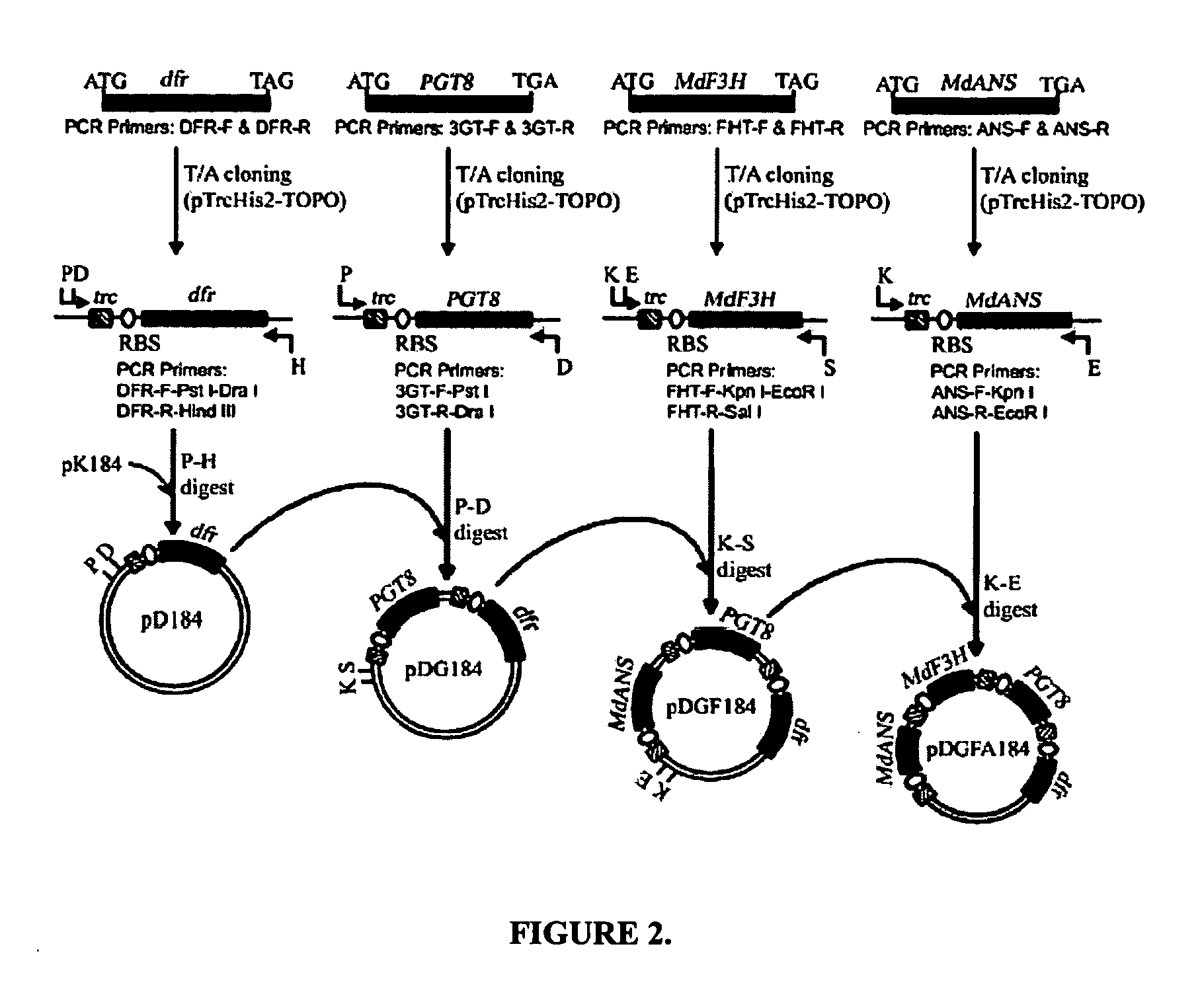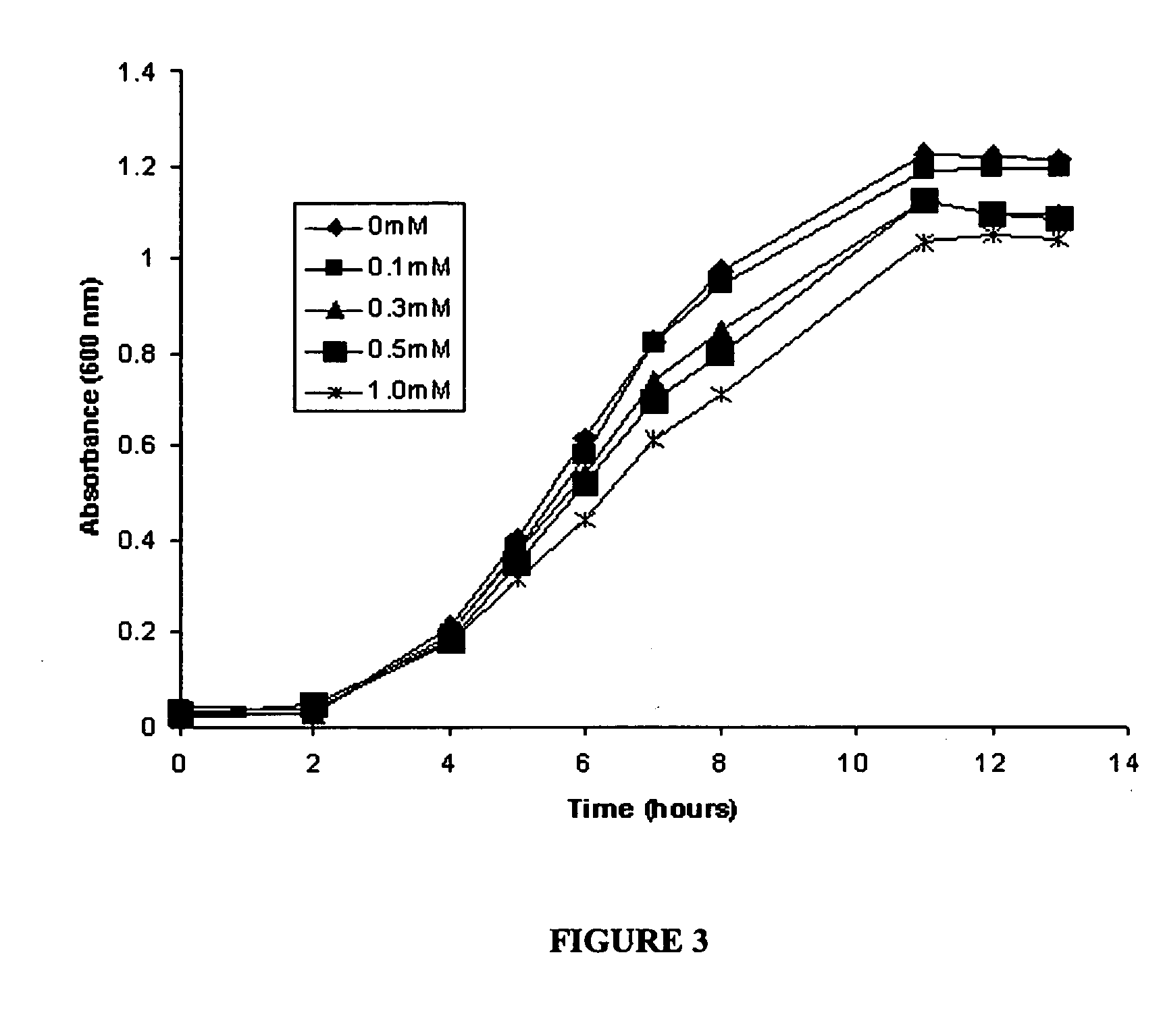Production of flavonoids by recombinant microorganisms
a technology of recombinant microorganisms and flavonoids, which is applied in the direction of lysine, transferase, enzymology, etc., can solve the problems of undeveloped satisfactory system, no microbial or yeast production of anthocyanidins, and hardly detected anthocyanidins in plant tissues
- Summary
- Abstract
- Description
- Claims
- Application Information
AI Technical Summary
Problems solved by technology
Method used
Image
Examples
example 1
[0070] This example describes the synthesis of anthocyanins by the expression of four plant derived genes in E. coli. The genes are involved in the lower anthocyanin biosynthetic pathway. An artificial gene cluster was constructed that contains the four genes of the lower anthocyanin biosynthesis pathway which converts the flavanone naringenin to one of the first colored and stable anthocyanins in this pathway, namely pelargonidin 3-O-glucoside. A set of genes encoding FHT (MdF3H) from Malus domestica, DFR (dfr) from Dianthus gratianopolitanus or Anthurium andraeanum, ANS (MdANS) from Malus domestica and 3-GT (PGT8) from Petunia×hybrida was used. We also demonstrate that naringenin, utilized as the starting substrate for the production of pelargonidin 3-O-glucoside, was efficiently transported into E. coli without significant toxic effects to the cell.
Material and Methods
[0071] Bacterial strains, plasmids and culture conditions. E. coli TOP10F, purchased from Invitrogen, was used...
example 2
[0088] In this example, we demonstrate the biosynthesis of plant specific flavonols from a bacterial species for the first time. This was achieved through the expression of gene clusters from heterologous plant sources in E. coli that allow the biosynthesis of flavanone precursor metabolites without the need of a chemical conversion. Using these gene clusters, the biosynthesis of the flavanone eriodictyol from E. coli. was also achieved.
Materials And Methods
[0089] Plant material, bacterial strains, plasmids and culture conditions. Parsley seeds were purchased from Stokes Seeds (Buffalo, N.Y.) while petunia plants were purchased from local nurseries. E. coli TOP10 (Invitrogen, Carlsbad, Calif.) was used for DNA manipulations while E. coli BL21Star (Promega) was used for shake-flask experiments. Plasmids pETDuet-1, pCDFDuet-1 and pRSFDuet-1 (Novagen) were used for cloning purposes.
[0090] Chemicals. Cinnamic acid, p-coumaric acid and caffeic acid were purchased from MP Biomedicals ...
example 3
[0108] This example describes the biosynthesis of milligram quantities of flavanone substances from S. cerevisiae recombinant strain for the first time. This has been achieved using a plant-derived gene cluster that proved to be stable in yeast despite the presence of repeated DNA sequences (GAL1 promoter).
Materials and Methods
[0109] Plant material, bacterial strain, yeast strains, plasmids and chemicals. Parsley seeds were purchased from Stokes Seeds (Buffalo, N.Y.) while petunia plants were purchased from local nurseries. S. cerevisiae strain INVSC1 (MATa his3D1 leu2 trp1-289 ura3-52) (Invitrogen, Carlsbad, Calif.) was employed for yeast transformation and shake flask experiments. E. coli TOP10F′ (Invitrogen) was used for plasmid construction and maintenance. S. cerevisiae plasmids pYES2.1N5-His-TOPO (Invitrogen) and YEplac181 (American Type Culture Collection, Manassas, Va.) were used for cloning purposes. p-Coumaric acid, cinnamic acid, caffeic acid and ferulic acid were purc...
PUM
| Property | Measurement | Unit |
|---|---|---|
| Volume | aaaaa | aaaaa |
| Mass | aaaaa | aaaaa |
| Mass | aaaaa | aaaaa |
Abstract
Description
Claims
Application Information
 Login to View More
Login to View More - R&D
- Intellectual Property
- Life Sciences
- Materials
- Tech Scout
- Unparalleled Data Quality
- Higher Quality Content
- 60% Fewer Hallucinations
Browse by: Latest US Patents, China's latest patents, Technical Efficacy Thesaurus, Application Domain, Technology Topic, Popular Technical Reports.
© 2025 PatSnap. All rights reserved.Legal|Privacy policy|Modern Slavery Act Transparency Statement|Sitemap|About US| Contact US: help@patsnap.com



